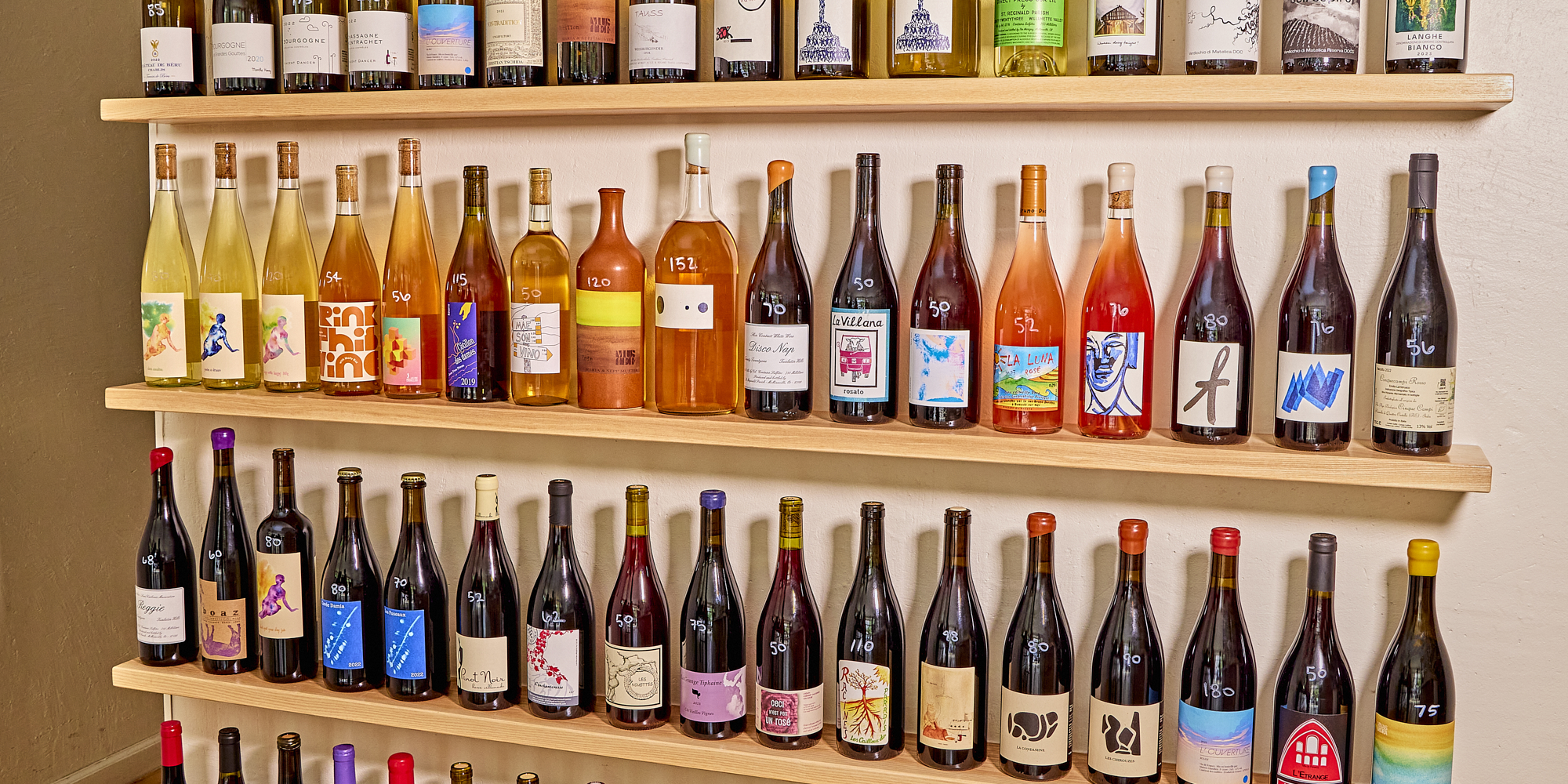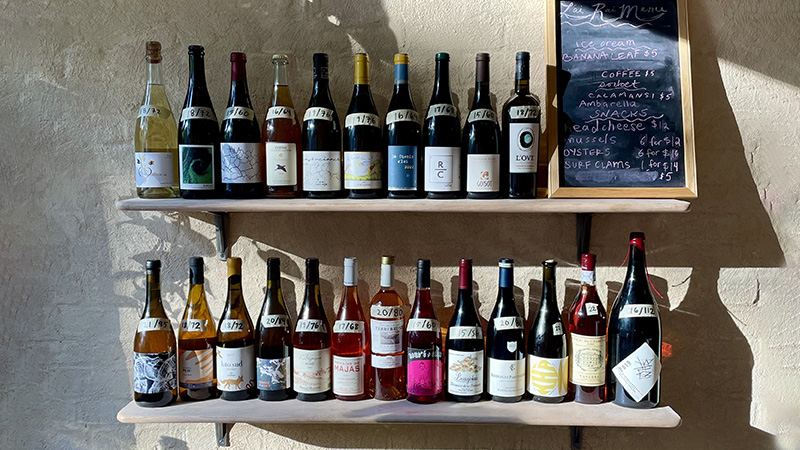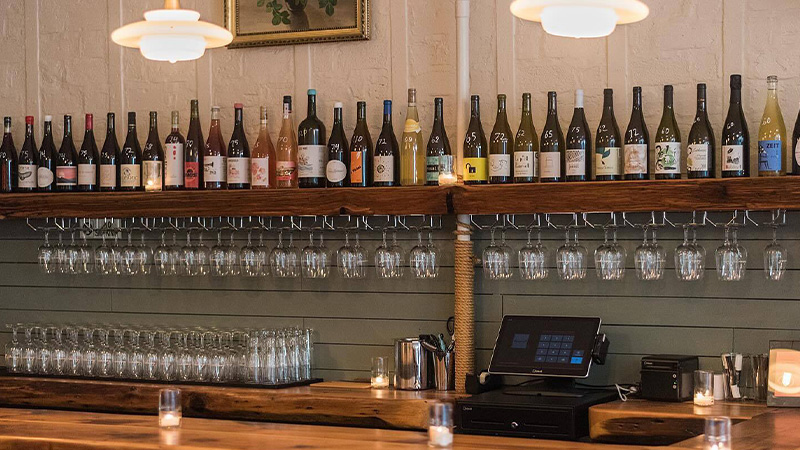
When guests walk into Plus de Vin, Brooklyn’s newest natural wine bar, they’re met with a floor-to-ceiling wall of technicolor bottles. Gazing at the shelves of dazzling options, from bright pink bubbly to neon orange skin-contact wines, one might feel like a kid in a candy store.
The striking bottles aren’t there for aesthetics — well, maybe to an extent — but the eye-catching wall of wine is meant to act as a visual menu. With prices written directly on bottles, guests can peruse the shelves, select a wine to buy right there at the counter, and enjoy it at the bar or in the charming back patio.
That’s right, Plus de Vin offers no printed menu, and it’s just one of the many new bars across New York embracing this approach.
Whether it be a long mantle above the bar, personalized cubbies for each wine, or rows of wooden shelves that evoke an indie bottle shop, popular new spots like Frog, Bouquet, Lai Rai, Whoopsie Daisy, and Rodeo are all ditching printed lists in favor of bottle displays. Sauced, an early-adopter of this model that opened in Williamsburg in 2020, stirred up some mixed responses for its complete lack of menu at first, but has undoubtedly become one of the buzziest natural wine bars in the U.S., launching new locations in Manhattan, Nashville, and now Los Angeles.
But why break from the time-old tradition of a written menu? All signs point to the natural movement, which changed consumers’ perceptions of what it means to produce and consume wine. Now it’s also influencing how people order wine.
Wonder-Wall
Since the dawn of the movement, many natural wine bars have sought to shake off wine’s stuffy reputation and make the beverage more accessible to all. But until recently, New York wasn’t exactly known for having a casual, care-free wine scene. The city undoubtedly offers some of the most comprehensive programs in the world. But even its coolest wine destinations have historically functioned as table-service establishments that boast robust programs and hefty lists, leaving a lack of fun spots where you can just walk in, sit back, and enjoy a bottle.
Carenn Mackinnon, co-owner of Plus de Vin, noticed this missing piece in New York’s bar landscape. She recalls feeling like most of her wine bar experiences of late included lengthy times spent reading long binder menus, which sapped the joy out of going out.
“I think there’s something very charming and romantic about a big printed wine list. It’s part of the pomp and circumstance of sitting at a restaurant,” Mackinnon says. “But it does feel very old school.”

So when she opened Plus de Vin, Mackinnon set out to create a space that inspired more interaction between both the guests and the service staff. “I just wanted something that felt a little fresher and engaging, rather than having your head in a book,” she says. Instead of guests each staring at individual lists, a group can collectively scan and discuss bottles at the wine wall together. Mackinnon or friendly staff members are always on hand to chat with curious customers and provide guidance and recommendations.
Bouquet, another new spot in Greenpoint, displays its full range of bottles on a long shelf above the bar. “A lot of wine bars that have more sit-down, restaurant-style service lean toward a bougie experience,” Bouquet owner Eric Molnar says. “I wanted to create a place that isn’t just the quintessential overpriced small plates natural wine bar. We have bottles that are $40, glasses that are $10, so people can come back multiple times a week and get a burger and glass of Gamay on a Wednesday or pop Champagne with friends on the weekends.”
“The average shopper isn’t memorizing producer names, so it provides a visual aid. Seeing a particular bottle might spark a reaction like, ‘Oh, I had that at a friend’s house, or I’ve had another wine from that producer.’”
Showcasing the wines above the bar and serving them counter-service style, Molnar finds that the set-up allows for each guest to lean into the wine experience as much as they want to. “Some people want a whole presentation and explanation behind each wine on the wall,” he says, “while others just want a glass of the dry white or orange wine and to be left alone.” It creates space where those interested in learning more about wine can do so in a friendly environment, but also doesn’t force someone to get too into the details if they don’t want to.
Full Transparency
Beyond providing an engaging and unpretentious way to discuss wine, displaying bottles along the bar likely resonates with younger consumers more than seeing producers or grape names written out in hefty lists. Between all-consuming social media and natural wine’s embrace of playful labels, a bottle’s visual appearance has become much more central to the way many consumers shop for wine.
Since the natural wine movement champions obscure grapes and underappreciated regions, wine lists aren’t all classic Pinot Noir and Sauvignon Blanc anymore, either. Guests might encounter grapes like Xarel-lo, Rkatsiteli, Valdiguié, or Grignolino on today’s modern wine bar menus. And unless they’re seasoned pros, it’s unlikely that they’ll know what style to expect. So more and more, consumers are relying on visual clues from the bottle itself.
For example, clear bottles indicate that a wine is meant to be drunk young, and the transparent glass helps drinkers see exactly the color of what’s inside. Something that’s bright pink, orange, or red generally screams juicy and chillable. Molnar notes Martha Stouman’s Post Flirtation red was a popular selection at Bouquet all the summer. The wine’s playful label and berry-red color make it clear what consumers are getting when they pop a bottle. However, if someone came into a natural wine bar looking for a light, quaffable red, and read the wine’s description as a Zinfandel-dominant blend from California, they might skip right over it.

Conor McKee, a co-owner of Whoopsie Daisy, noticed a similar pattern of guests recognizing bottles more by their appearances than their names or regions. The bar is a new project from the team behind Fiasco, a natural wine shop located across the street in Brooklyn’s Crown Heights neighborhood.
These new spots seem to have cracked the code for what can work in the city, bringing the feel of the breezy, Parisian bar where you can walk in without a reservation, order a glass for 8 euros or grab a bottle from the wall with a few friends, and sit for hours.
McKee mentions that at Fiasco, they’ve noticed how often people shop by label. So when they opened Whoopsie Daisy, they wanted to offer a way for people to visually peruse the selection. “The average shopper isn’t memorizing producer names, so it provides a visual aid,” McKee says. “Seeing a particular bottle might spark a reaction like, ‘Oh, I had that at a friend’s house, or I’ve had another wine from that producer.’”
Hacking New York
The wine caves in Paris and bars across European cities have long embraced this format as wine shops can sell bottles for both on- and off-premise consumption. Some trailblazing bars across America have also already adapted this model, like Light Years in Houston, LoLo in Austin, and Good Clean Fun in L.A., where drinkers can buy a bottle to stay or to go from the beautifully curated shelves.
In New York, liquor laws prohibit wine bars and restaurants from selling products for off-premise consumption — so the city is actually late to the trend. But these new spots seem to have cracked the code for what can work for them, bringing the feel of the breezy, Parisian bar where you can walk in without a reservation, order a glass for 8 euros or grab a bottle from the wall with a few friends, and sit for hours.
The counter service and interactive displays give these bars the same atmosphere as the casual European bars that undoubtedly acted as inspiration. And ditching table-side service allows them to feature bottles at more approachable prices. The fact that spots like Frog, Sauced, Lai Rai, Bouquet, Rodeo, and Plus de Vin are all buzzing with young customers shows that the model is connecting with curious wine drinkers — even in a city that’s notoriously pretentious about wine.
The article For These New York Bars, Interactive Wine Walls Have Replaced Written Lists appeared first on VinePair.






